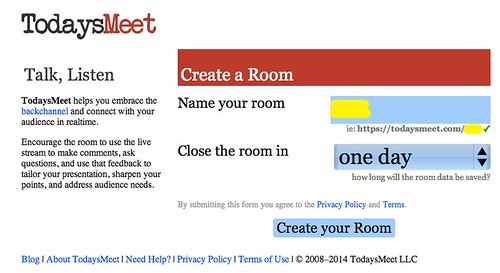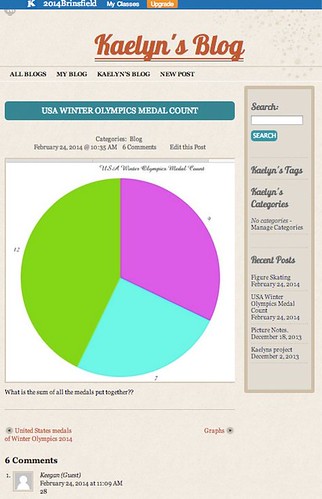I’ve used “backchannel” websites and collaborative documents MANY times with teachers during professional development sessions and conferences, as well as with graduate and undergraduate students in classes. Monday I substituted for one of our fifth grade teachers who was out sick, however, and this provided me with my first chance to use a text backchannel with two different classes of fifth graders. Free “interactive writing” websites like TodaysMeet, EtherPad documents hosted free on sites like TitanPad or MeetingWords, or a Google Doc set to allow open editing can be helpful spaces to solicit student thoughts in a lesson. Since I have an iPad cart in my STEM classroom (and Monday is my planning day, when I’m not required to substitute teach) I decided to utilize my iPad cart as a sub. Here are a few of my lessons learned about this initial backchannel experience with fifth graders, as well as some details from our math lesson which might include things you could try with students using iPads.
Every single time I’ve ever provided upper elementary students with an open space to text chat with each other, at least one student always “blows it” within the first five or ten minutes. This happens no matter how much preparatory discussions we have about digital citizenship, being accountable for what you say in online spaces as well as face-to-face, etc. It just comes with the territory, this is what students do: Explore and push the boundaries. And I’m OK with that. Over time I’ve come to understand that these conversations about appropriate use of text chat, and having a student sit-out for a short time from the synchronous online chat as a consequence of a poor decision, are EXACTLY the kind of conversations and interactions I want to be having regularly with students regarding interactive digital media. Whether we’re using the open chat features of MinecraftEDU or using TodaysMeet, I’ve learned to expect some students to “mess up” but the conversations we have as a result to be important, needed, and beneficial.
Anticipating that at least one student in each class would post something in our TodaysMeet that wouldn’t be kind or appropriate, I chose to let the room expire / go offline after just 1 day. This is a very good thing, since I didn’t particularly want to archive the formative interactive writing experiences we had for a long time. When you first setup a TodaysMeet room, you decide how long the room will stay online. Weigh different factors when making this decision. For me in Monday’s situation, a 1 day room was perfect.
I always make a rule with text chat environments that students use their real first name. No one is allowed to be anonymous or use a pseudonym. If students need to change their name (to their real name) they can simply refresh their Safari browser window and then JOIN the TodaysMeet again with their correct name.
The fifth graders I was teaching on Monday had been studying fractions, percentages, and interpreting pie graphs. Rather than do a provided worksheet on pie graphs, I decided to use some current statistics from the winter olympics, have students create their own pie graphs, and then blog a screenshot of their pie graph with a challenging question other students could then answer via blog comments. Last semester in November and December, I taught both these classes of fifth graders how to blog with both text and images using iPads and the KidBlog app. Since their classroom KidBlog sites were already setup and they knew (most of them) how to post to them, this proved to be a relatively engaging and successful lesson.
I started the lesson with a discussion of the winter olympics, and we used the backchannel to share about our favorite Olympic sports. I wanted to lead up to a discussion of the science of figure skating and share an ASAPscience video about that, so I shared the 5 minute video “OLYMPIC GAMES CLOSING CEREMONY Javier Fernandez in the Figure Skating Gala Event 2014.” We used the backchannel to share ideas and responses to this figure skating performance. I prefaced the video with some questions about how figure skaters spin fast.
We discussed what we’d observed in the video, especially with the figure skating spins, and then watched “The Science of Figure Skating” by ASAPscience.
I shared these videos from my iPad2, mirroring its display through my laptop with AirServer to the classroom Smartboard. I joined into the TodaysMeet backchannel using my iPhone during the videos, since both my iPad and laptop were tied up sharing them.
After watching this second video, I muted and replayed it as we discussed some of the terms and math statistics from it. Some of these had been shared by students in the TodaysMeet backchannel.
After that discussion, I explained to the students that they were going to use data from the 2014 winter olympics medal counts to create a pie graph today. I love how simply Googling “2014 winter olympics medal count” produced an interactive table of statistics we could use for this project. Students explored and learned they could click on individual countries and events to get more details. We discussed how some countries with higher total medal counts were ranked lower than others who had a larger number of gold medals.
I shared the link to that Google Search with students using a QR Code. I used the free iPhone app (on my iPad) QR Code Beamer to create the QR Code “on the fly.” I used the same app to next have students link to the free NCES “Create a Graph” website. It does not require Flash so it works great on the iPads using the Safari web browser.
I showed students how to create a simple pie graph using a title and “3 slices” or data points, for the gold, silver and bronze medals a particular country earned in this year’s winter olympics. I reminded students how they could take a screenshot of their iPad screen, when they were zoomed into the “preview” of their graph, and then crop that picture in the Photos app before posting it to their classroom KidBlog site. Here is a screenshot of one of the students’ posts, which includes their labeled pie graph and question, along with classmates’ answers.
During the lesson when I shared QR codes with students, they scanned them using the free i-Nigma QR code scanner app. It’s the fastest QR code scanner I’ve used and seen for the iPad.
I’ve always liked math assignments where students are required to come up with questions about a particular topic or skill. This assignment did not lead to lots of deep and complex thinking about pie graphs, but all the students in each class were able to successfully create and post a pie graph using their iPads and most of them also answered some of the questions their classmates had posted. As a “teacher” and administrator of their classroom KidBlog websites, I was able to moderate both student posts and comments in class so they could see and respond to each others’ ideas. I felt it was a successful lesson overall.
I did not tell students the direct link to the TodaysMeet backchannel we used during the lesson, but instead had them connect to it using a QR Code. At the end of the day when some students had finished their work and had a little free time with their iPads, some of them did return to the TodaysMeet and chat some mildly inappropriate things to each other. This was easy to identify and address because of the laughter, as I circulated around the room, and also led (as before) to some important and needed conversations on responsibility and accountability for online behavior.
This was the first time these fifth graders had ever used iPads during their “regular” math class, and the first time they’d used a backchannel of any kind in school. They’d used iPads and posted to KidBlog with me in STEM class the previous semester, but a lot of what we did technologically was new. As the novelty of using a backchannel would wear off, if this was something they did on a regular basis, I think the amount of off-task and inappropriate use of the backchannel would also subside. All of these dynamics reinforce how important it is to regularly check-in with students during a lesson to confirm they are on-task and making good decisions with their technology tools. It also demonstrated the benefit of having a backchannel space which expired in 1 day.
I feel thankful and blessed to have the opportunity to teach with an iPad cart both in my classroom and in the classroom where I substituted on Monday. Hopefully in the not-too-distant future, all our students will have iPads or laptops which they can use to regularly engage in “interactive writing” like we did together for these integrated math lessons.
Technorati Tags: blog, cart, ipad, science, writing, interactive, graph, olympics, asapscience







Comments
One response to “Backchannel with 5th Graders & Pie Chart Questions on the Winter Olympics”